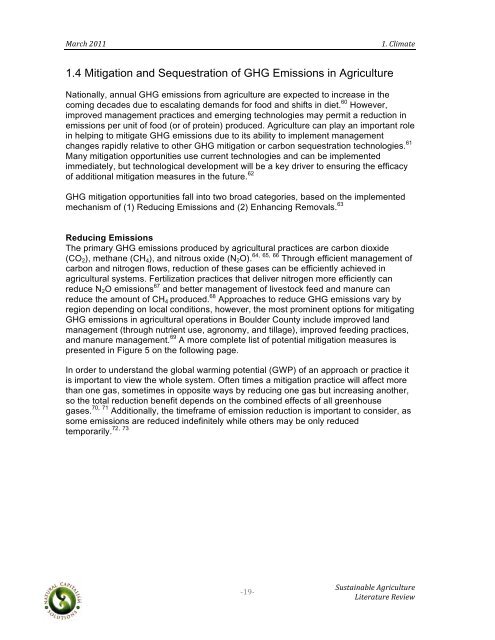Sustainable Agriculture Literature Review - Boulder County
Sustainable Agriculture Literature Review - Boulder County
Sustainable Agriculture Literature Review - Boulder County
Create successful ePaper yourself
Turn your PDF publications into a flip-book with our unique Google optimized e-Paper software.
! ! !!<br />
"#$%&!'())! !!!!!!!!!!!!!!!!!!!!!!!!!!!!!!!!!!!!!!!!!!!!!!!!!! )=!>1.;#-2!<br />
1.4 Mitigation and Sequestration of GHG Emissions in <strong>Agriculture</strong><br />
Nationally, annual GHG emissions from agriculture are expected to increase in the<br />
coming decades due to escalating demands for food and shifts in diet. 60 However,<br />
improved management practices and emerging technologies may permit a reduction in<br />
emissions per unit of food (or of protein) produced. <strong>Agriculture</strong> can play an important role<br />
in helping to mitigate GHG emissions due to its ability to implement management<br />
changes rapidly relative to other GHG mitigation or carbon sequestration technologies. 61<br />
Many mitigation opportunities use current technologies and can be implemented<br />
immediately, but technological development will be a key driver to ensuring the efficacy<br />
of additional mitigation measures in the future. 62<br />
GHG mitigation opportunities fall into two broad categories, based on the implemented<br />
mechanism of (1) Reducing Emissions and (2) Enhancing Removals. 63<br />
Reducing Emissions<br />
The primary GHG emissions produced by agricultural practices are carbon dioxide<br />
(CO2), methane (CH4), and nitrous oxide (N2O). 64, 65, 66 Through efficient management of<br />
carbon and nitrogen flows, reduction of these gases can be efficiently achieved in<br />
agricultural systems. Fertilization practices that deliver nitrogen more efficiently can<br />
reduce N2O emissions 67 and better management of livestock feed and manure can<br />
reduce the amount of CH4 produced. 68 Approaches to reduce GHG emissions vary by<br />
region depending on local conditions, however, the most prominent options for mitigating<br />
GHG emissions in agricultural operations in <strong>Boulder</strong> <strong>County</strong> include improved land<br />
management (through nutrient use, agronomy, and tillage), improved feeding practices,<br />
and manure management. 69 A more complete list of potential mitigation measures is<br />
presented in Figure 5 on the following page.<br />
!<br />
In order to understand the global warming potential (GWP) of an approach or practice it<br />
is important to view the whole system. Often times a mitigation practice will affect more<br />
than one gas, sometimes in opposite ways by reducing one gas but increasing another,<br />
so the total reduction benefit depends on the combined effects of all greenhouse<br />
gases. 70, 71 Additionally, the timeframe of emission reduction is important to consider, as<br />
some emissions are reduced indefinitely while others may be only reduced<br />
72, 73<br />
temporarily.<br />
!<br />
"+*"<br />
!*+,-#./#012!34$.%+1-+$2!<br />
5.-2$#-+$2!627.28!
















